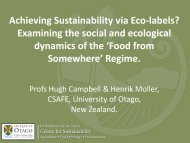Book of Abstract (incl. addendum) - IFSA symposium 2012
Book of Abstract (incl. addendum) - IFSA symposium 2012
Book of Abstract (incl. addendum) - IFSA symposium 2012
You also want an ePaper? Increase the reach of your titles
YUMPU automatically turns print PDFs into web optimized ePapers that Google loves.
Workshop 1.3 Understanding agricultural structural changes and their impacts, to support<br />
<strong>incl</strong>usive policy dialogue and formulation<br />
(Semi)Subsistence Agricultural Systems in Sierra Leone: Present and<br />
Future Challenges<br />
Silvia L. Saravia Matus, Szvetlana Acs and Sergio Gomez y Paloma<br />
European Commision – Joint Research Centre – IPTS<br />
Silvia.Saravia-matus@ec.europa.eu<br />
The views expressed are purely those <strong>of</strong> the authors and may not in any circumstances be regarded as<br />
stating an <strong>of</strong>ficial position <strong>of</strong> the European Commission.<br />
The Government <strong>of</strong> Sierra Leone has recently published its National Sustainable Agriculture<br />
Development Plan (NSADP) 2010-2030 which contemplates the gradual erradication <strong>of</strong> shifting<br />
cultivation practices and the active promotion <strong>of</strong> vertically integrated processing and<br />
commercialisation chains for selected staple (rice and cassava) and export crops (cocoa and c<strong>of</strong>fee).<br />
The aim <strong>of</strong> this article is to examine the implications <strong>of</strong> the changing agricultural policy for<br />
(semi)subsistance farmers who represent about two-thirds <strong>of</strong> the Sierra Leonean population. For this<br />
purpose farm typologies are introduced according to the diversity <strong>of</strong> cultivated crops. The analysis<br />
focuses on smallholders' food security, employment opportunities and access to inputs and natural<br />
resource. For this purpose, socio-economic data from a 2009 survey to 600 farm-households under the<br />
two main production systems <strong>of</strong> Sierra Leone are used. Results illustrate the potential impact on rural<br />
livelihoods during the implementation <strong>of</strong> the NSADP (<strong>incl</strong>uding land leasing processes) and the<br />
challenges related to the transition period required to effectively replace shifting cultivation with<br />
permanent agricultural systems.<br />
Large scale foreign land acquisitions in Madagascar: what interactions,<br />
opportunities and risks for different local farming systems?<br />
Katy Medernach, P. Burnod and H. Rakotomalala<br />
Malagasy Land Observatory, Madagascar<br />
Katy-medernach@yahoo.com<br />
Important foreign land acquisitions in developing countries can lead to structural transformation in<br />
existing farming systems. But does the development <strong>of</strong> mega-farms create the same opportunities and<br />
risks for the diversity <strong>of</strong> local rural households? Based on a case study in Madagascar, this paper<br />
deciphers the transformations <strong>of</strong> the local agrarian systems due to the implementation <strong>of</strong> an<br />
agrobusiness company, aiming to produce jatropha on 5000 hectares. Focusing on the local level, it<br />
deciphers the ongoing impacts and tries to overcome a vision <strong>of</strong> the “local community” as an<br />
homogenous and congruent entity.<br />
Even if the plantations are still small (230 hectares), the company implementation impacts on the<br />
local labor market (wage increase, transition accelerated from mutual aid system to labor market),<br />
migration flows (new immigration and less seasonal emigration), the local farming systems (vegetable<br />
production stops due to commoditization <strong>of</strong> manure, development <strong>of</strong> onions thanks to new comers’<br />
experience, adaptation <strong>of</strong> cattle bredding). Above all, the company plots encroach on appropriated land<br />
and generate conflict with the villagers. While the smaller farmers benefit from the company<br />
implementation (jobs, infrasctures access), the larger famers and herders are the ones who lose access<br />
to land, experience an income decrease and then oppose the company implementation. The company<br />
development also reactivates land conflicts between villagers (schematically Betsileo farmers and<br />
Sakalava herders) who both compete to have control over land access. Hence, neither investor nor<br />
local landwners manage to have secure and legal land rights.<br />
A better understanding <strong>of</strong> the agrarian system and the local tenure practices is necessary to<br />
identify the diverse stakeholders and interests in welcoming/opposing the company. A better view on<br />
whom benefit/lose from the company development, whom has land rights and whom has control over<br />
30











